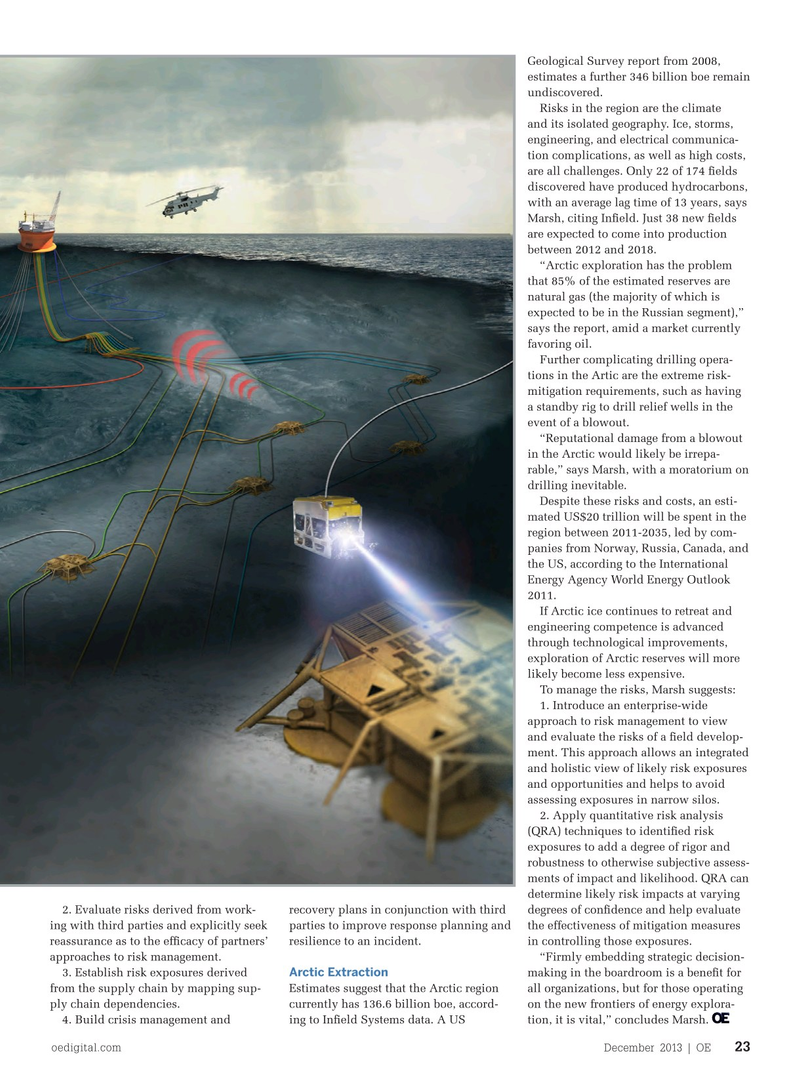
Page 21: of Offshore Engineer Magazine (Dec/Jan 2013)
Read this page in Pdf, Flash or Html5 edition of Dec/Jan 2013 Offshore Engineer Magazine
Geological Survey report from 2008, estimates a further 346 billion boe remain undiscovered.
Risks in the region are the climate and its isolated geography. Ice, storms, engineering, and electrical communica- tion complications, as well as high costs, are all challenges. Only 22 of 174 felds discovered have produced hydrocarbons, with an average lag time of 13 years, says
Marsh, citing Infeld. Just 38 new felds are expected to come into production between 2012 and 2018.
“Arctic exploration has the problem that 85% of the estimated reserves are natural gas (the majority of which is expected to be in the Russian segment),” says the report, amid a market currently favoring oil.
Further complicating drilling opera- tions in the Artic are the extreme risk- mitigation requirements, such as having a standby rig to drill relief wells in the event of a blowout. “Reputational damage from a blowout in the Arctic would likely be irrepa- rable,” says Marsh, with a moratorium on drilling inevitable.
Despite these risks and costs, an esti- mated US$20 trillion will be spent in the region between 2011-2035, led by com- panies from Norway, Russia, Canada, and the US, according to the International
Energy Agency World Energy Outlook 2011.
If Arctic ice continues to retreat and engineering competence is advanced through technological improvements, exploration of Arctic reserves will more likely become less expensive.
To manage the risks, Marsh suggests: 1. Introduce an enterprise-wide approach to risk management to view and evaluate the risks of a feld develop- ment. This approach allows an integrated and holistic view of likely risk exposures and opportunities and helps to avoid assessing exposures in narrow silos. 2. Apply quantitative risk analysis (QRA) techniques to identifed risk exposures to add a degree of rigor and robustness to otherwise subjective assess- ments of impact and likelihood. QRA can determine likely risk impacts at varying 2. Evaluate risks derived from work- recovery plans in conjunction with third degrees of confdence and help evaluate ing with third parties and explicitly seek parties to improve response planning and the effectiveness of mitigation measures reassurance as to the effcacy of partners’ resilience to an incident. in controlling those exposures. approaches to risk management. “Firmly embedding strategic decision-
Arctic Extraction 3. Establish risk exposures derived making in the boardroom is a beneft for from the supply chain by mapping sup- Estimates suggest that the Arctic region all organizations, but for those operating ply chain dependencies. currently has 136.6 billion boe, accord- on the new frontiers of energy explora- 4. Build crisis management and ing to Infeld Systems data. A US tion, it is vital,” concludes Marsh. oedigital.com December 2013 | OE 23 022_OE1213_frontier2.indd 23 11/22/13 2:38 PM

 20
20

 22
22